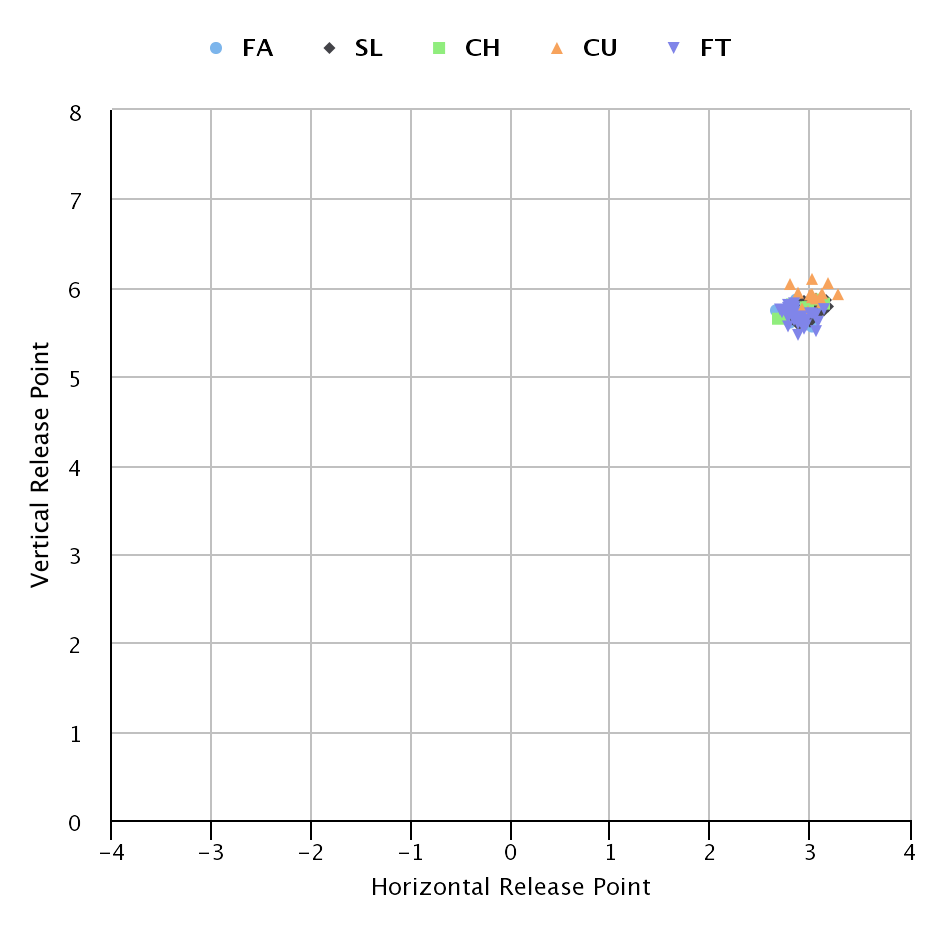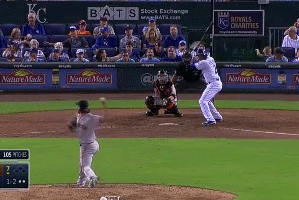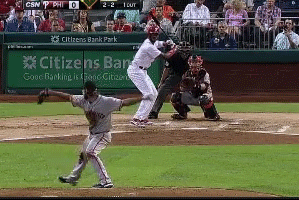Breaking Down Madison Bumgarner
The Giants saved their ace for the Wild Card game. Though Madison Bumgarner has been a snot-rocket champion for some time, and a top pitcher, he’s turned it up a notch the last two seasons. A couple adjustments — one in approach and the other in mechanics — seem to have fueled this latest improvement. Those changes can also provide us the nitty gritty to watch for when he takes the mound with the Giants’ postseason on the line tomorrow.
For a few years now, Bumgarner has thrown about as many cutters as four-seamers. That puts him in the top 30 year-to-year in cutter+fastball usage. But something looks a little different recently. Check out his pitch mix according to Brooks Baseball:
Looks like he’s been going to the fastball more recently. “I’m big on doing whatever’s working at the time,” Bumgarner said before a game with the Padres in the final week of the season. “So if I have a good one I’m going to stick with it until it’s not working. Whatever’s working I’ll try to use to get outs with.”
In particular, the lefty has gone to the high fastball a bit more often recently. Particularly in his near-no-hitter against the Rockies , the lefty has lived higher in the zone. Check out his pitches earlier in the year on the left compared to his work since August first on the right.
Bumgarner agreed that he’d noticed it, particularly in that start against Colorado. “It’s a game of adjustments,” he felt. “Pitchers are always taught down in the zone, down in the zone, get ground balls. So the hitters are going to adjust to that. They’re not going to want to be okay with not being able to hit that pitch. It’s about staying ahead of the game and trying to make adjustments as fast as you can.”
Another change in the lefty’s game has come from his positioning on the mound. You can spot it fairly easily on our game charts because it changed from one game to the next mid season. On the left are his release points from the July 13th game against Arizona at home. On the right are his release points from his next start, July 18th in Miami.
Bumgarner confirmed the move, saying that he now sets up on the third base side of the rubber. “I face more righties than lefties, so I feel like the closer you get to them, the tougher you’ll be on them,” he said. We know from early research on effective velocity that this is true, and we can see that his first-half numbers against righties (.263/.320/.402) were worse than his second-half numbers against righties (.215/.246/.381).
Those two changes may help augment his cutter as well. He knows that some people call it a slider, or think he has two different pitches. “I call it a cutter but I feel like it’s in between the two — I think people call it different things because I change speeds with it,” he said. “But I throw it the same.” Sliders and cutters traditionally have the same grip, so no big deal really.
That doesn’t mean it’s your traditional cutter. It changes shape according to Bumgarner’s intent. “The slower you throw it, the more it’s going to break, so it’s going to go down more,” the lefty said. “The harder one is not going to break as much, so it looks flatter. If I throw it lower in the zone, it’ll go down more because of the angle. I’ll throw it high too though, to make it look flatter.”
That’s how you get a heat map for the cutter that shows a willingness to throw the pitch anywhere in the zone:
And if you look at the break and velocities on his cutters, you’ll see those subtle differences highlighted. Take particular notice about how the harder cutters (darker green circles, in the upper right corner) move more like his fastball, and the softer cutters (lighter green circles, in the lower left part of the graph) move more like his curveball.
But if you watch two cutters from different ends of the spectrum, it’s not that easy to tell them apart. On the left is a slow cutter (85.7mph, bottom 3% in velocity this year), on the right is a hard cutter (90.2 mph, top 3% in velocity this year). The difference is more subtle than stark — only three inches of movement separate the two after all — but can still show you what some would call the gap between a slider and a cutter.
Bumgarner has worked hard to make his pitches very similar. Even though he’s messed with grips in the past (“a thousand different ways”), he’s settled on what he’s got. “Right now, I try to make everything look the same with the spin on the ball,” he said. “So they see the same spin, it’s harder for them to adjust.”
That work does include video from time to time, but the technology isn’t quite there yet for Bumgarner. “Usually I find that I can’t really see it on video,” Bumgarner says of trying to fix mechanical issues. “It’s hard to see because of the frames per second that the video gets — sometimes it moves too far and you don’t really get that resolution that you need.”
So he works with a mirror, doing dry drills and watching his keys, making sure he sets up in the right places, his hands go to the right places, and everything feels right. “I’m analytical about a lot of it, but some of it I just let it happen how it’s going to happen,” Bumgarner explained. “The biggest key for me, besides lining up and making sure that’s the same every time, is staying slow until the very end.”
With a couple adjustments in hand — the high fastball and the new spot on the rubber in particular — Bumgarner is ready to make the most of his old playbook. Throw lots of fastballs, cutters, and curves, all from the same release point, all with similar spin, and all exploding out of a slow, deliberate delivery — and watch as the batters barely miss each pitch.
With a phone full of pictures of pitchers' fingers, strange beers, and his two toddler sons, Eno Sarris can be found at the ballpark or a brewery most days. Read him here, writing about the A's or Giants at The Athletic, or about beer at October. Follow him on Twitter @enosarris if you can handle the sandwiches and inanity.








Nice analysis. This is exactly what it looks like from watching his games and listening to Kruk’s commentary. I don’t think Kruk has commented on which side of the rubber he sets up on.